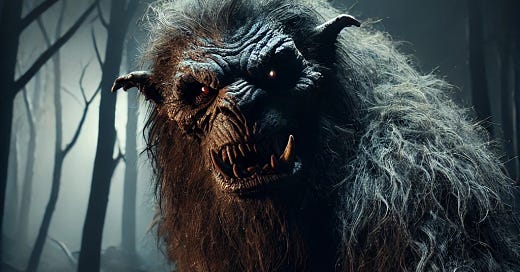Myth of the Day: Bugbear
In a Celtic forest, the bear-like, goblin-faced bugbear embodies ancient cautionary tales, enforcing moral behavior with a sinister presence.
Region/Culture: England, Northern Europe
Mythos: Celtic Mythology
Primary Type/Nature: Monsters and Beasts
Mythical Attributes: Often depicted as a bear-like goblin or boogeyman, designed to scare children.
Role in Mythos: The bugbear serves as a cautionary figure in folklore, used to warn children against bad behavior.
Relation to Humans: Traditionally employed as a scare tactic for children, the bugbear is said to stalk those who misbehave. Its role is to instill fear and promote good behavior among young humans.
In the shadowy embrace of medieval England’s forests, where the trees seemed to huddle together as if whispering secrets, the bugbear prowled. A creature of unnerving duality, it was the worst kind of enigma: part lumbering beast, part malevolent goblin, and entirely unsettling. Imagine a bear, monstrous in size and power, its fur the coarse, snarled result of centuries spent unseen by civilization. But look closer—its face betrays a cruel intelligence, its eyes glinting with a goblin’s gleeful malice. Its claws, more akin to spindly fingers, clutch and scrape at the earth with a hunger that speaks of more than just food. The bugbear is a thing of nightmares, summoned not by sorcery but by the human need to explain and control.
The bugbear’s origins are more whispers than words, born from folklore that swirls and reshapes with each telling. The name itself comes from the Middle English “bugge,” a term for something frightening, tied to the Old Welsh bwg or Old Scots bogill, each meaning an evil spirit or goblin. Unlike the grand progeny of gods or victims of divine curses, the bugbear crawled into existence as a shadow on the edge of human imagination. Its purpose was simple but insidious: to serve as a warning. “The bugbear waits,” parents would say, “for children who stray too far or dare to misbehave.”
Tales of the bugbear rarely follow the structure of a singular mythic journey. Instead, they are fragmented, like cautionary notes scribbled in the margins of life. One story tells of a child who ignored their mother’s warnings, wandering too far into the woods. They returned pale and trembling, unable to speak of what they’d seen—only able to scream when night fell. Another tale speaks of a village where a bugbear took residence on its outskirts, its hulking shadow a constant threat to those who dared the forest path after dusk. These tales, as chilling as they were inconsistent, always served their purpose: they kept children close and curiosity contained.
The bugbear is more than its form; it possesses abilities that make it the perfect predator of folklore. It moves with an unnatural silence, a ghost in the trees. It sees through the blackest nights, its vision cutting through shadows as easily as it instills fear. This fear is not ordinary—it’s described as an oppressive dread, seeping into the soul and rooting itself there, leaving its victims paralyzed long before the creature appears. The bugbear doesn’t merely hunt; it preys on the mind as much as the body.
Yet for all its terror, the bugbear is vulnerable in surprising ways. Its very existence depends on belief. Without the stories and the warnings, the bugbear is little more than a memory, its form dissolving like mist under the sun. There is also a curious morality binding it. The bugbear is not indiscriminately cruel—it is a creature of rules. Harm does not come to those who tread carefully, follow the path, and heed their elders. Its wrath is reserved for those who stray, who defy, who challenge the invisible boundaries of their world.
And so the bugbear remains, a relic of times when the forest was vast, the night was full of terrors, and obedience was the price of safety. Even as the modern world encroaches, with its lights and rational explanations, the bugbear lingers in the minds of those who grew up hearing its name whispered as both a threat and a warning. It waits not in the woods, but in the darker corners of memory, where shadows still stretch long and the imagination runs wild.
Suggested Further Reading
Explore more myths and wonders by visiting godsandmonsters.info.
Enjoy mythic tales on the move with our podcast, Five Minute Mythology.





